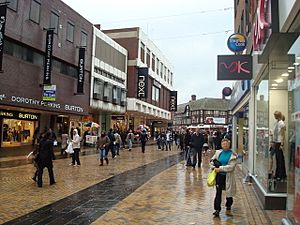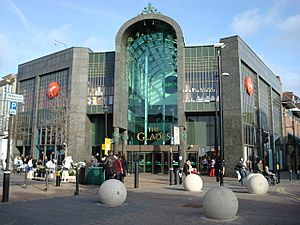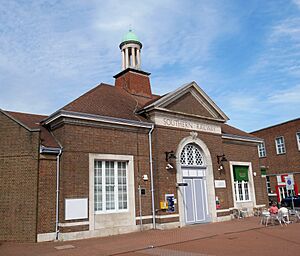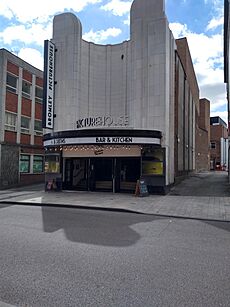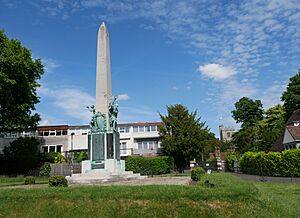Bromley facts for kids
Quick facts for kids Bromley |
|
|---|---|
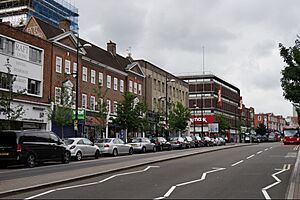 Bromley town high street |
|
| Population | 87,889 |
| OS grid reference | TQ405695 |
| • Charing Cross | 9.3 mi (15.0 km) NW |
| London borough | |
| Ceremonial county | Greater London |
| Region | |
| Country | England |
| Sovereign state | United Kingdom |
| Post town | BROMLEY |
| Postcode district | BR1, BR2 |
| Dialling code | 020 |
| Police | Metropolitan |
| Fire | London |
| Ambulance | London |
| EU Parliament | London |
| UK Parliament |
|
| London Assembly |
|
Bromley is a large town in Greater London, England. It's part of the London Borough of Bromley. The town is about 9.5 miles (15 km) southeast of Charing Cross in central London. In 2023, about 88,000 people lived here.
Bromley was once a part of Kent. It became a busy market town after getting special permission to hold a market in 1158. Its location on a main travel route and the opening of a railway station in 1858 helped it grow a lot. It changed from a farming village to a lively town. As London grew in the 20th century, Bromley's population increased. It officially became a town council area in 1903 and joined the London Borough of Bromley in 1965. Today, Bromley is a big shopping and business hub. It's even named as one of the 13 main city centers in Greater London.
Contents
History of Bromley
Bromley is first mentioned in an old document from 862. It was called Bromleag, which means 'a clearing in the woods where broom plants grow'. This name is similar to Great Bromley in Essex, but not to Bromley-by-Bow in East London.
The town's history is closely linked to the Bishops of Rochester. In 862 AD, King Ethelbert of Kent gave land to create the Manor of Bromley. Later, in 1185, Bromley Palace was built by Gilbert Glanvill, who was the Bishop of Rochester. People on religious journeys used to visit St. Blaise's Well in the town. The Bishops owned the Palace until 1845. Then, Coles Child, a rich local businessman who helped others, bought Bromley Palace and became the lord of the manor.
Bromley was an important stop for coaches traveling from London to Hastings. The old Royal Bell Hotel, near Market Square, is even mentioned in Jane Austen's famous book Pride and Prejudice. Bromley was a quiet village until the railway arrived in 1858 in Shortlands. This led to fast growth, and new neighborhoods like Bickley and Bromley Common were built. Many people wanted to live there because it was so close to London.
Bromley was also known as Bromley St Peter and St Paul. It was an old parish in Kent. In 1840, it became part of the larger Metropolitan Police District. The town started its own local health board in 1867. This board became the Bromley Urban District Council in 1894. In 1934, the town grew even more, adding land from nearby areas like Farnborough, Hayes, Keston, and West Wickham. In 1965, Bromley became part of the new Greater London area, within the London Borough of Bromley.
Who Represents Bromley?

Bromley is part of the Bromley and Biggin Hill area for the UK Parliament. The current Member of Parliament (MP) for this area is Peter Fortune. Thomas Turrell is the London Assembly member for the Bexley and Bromley area, which includes Bromley.
A very famous MP from Bromley was Harold Macmillan, who used to be the Prime Minister of the UK.
What's the Weather Like?
Bromley has a mild climate, meaning the differences between high and low temperatures are not extreme. It's known as a "Marine West Coast Climate" or "Oceanic climate."
Bromley's Economy and Shopping
Bromley is one of the main city centers in the London Plan. In 2018, people in Bromley had one of the highest average incomes in the UK.
In 2005, Bromley was ranked fourth in Greater London for its retail (shopping) area. It was behind the West End, Croydon, and Kingston upon Thames. Bromley is a popular shopping spot and competes with Croydon and the Bluewater shopping center in Dartford.
Bromley High Street
The town has a large shopping area, including a High Street where only people can walk (no cars). The main shopping mall is called The Glades. Many people, about 1.3 million, live close enough to shop there. You can find stores like Gap, Oasis, Foot Locker, and Waterstone's. A new development at St. Mark's Square has added more restaurants and a cinema.
Bromley High Street also hosts the Bromley Charter Market. This market happens every Tuesday, Thursday, and Saturday. King John first allowed the market to be held on Tuesdays in 1205. Later, Henry VI changed it to Thursdays in 1447. The market sells food, sweets, clothes, and other items like jewelry.
Getting Around Bromley
Bromley has two main train stations. Bromley South offers train services to London Victoria, London Blackfriars, Orpington, Sevenoaks, Ramsgate, Dover Priory, and Ashford International.
Bromley North has shuttle services to Grove Park. From there, you can connect to trains going to London Charing Cross and London Cannon Street.
Shortlands railway station is just southwest of the town center. It's one stop west of Bromley South and connects to London Victoria and London Blackfriars.
Buses in Bromley
Bromley is well-served by many London Buses routes. These buses connect Bromley to nearby areas like Beckenham, Bexley, Croydon, Lewisham, Orpington, and West Wickham.
Culture and Fun in Bromley
Festivals
Since 1929, Bromley has held an annual festival in May. It features "dance, drama, and comedy" at different places around town. The South London Film Festival has also been held in Bromley every year since 2022.
Bromley has many open spaces like Norman Park and Beckenham Place Park. These are great for outdoor concerts, festivals, and movie screenings.
Theatres
Bromley has several theatres. In the town center, there's the Churchill Theatre, which is a professional theatre. There's also the Bromley Little Theatre, which is for amateur performances, and an outdoor amphitheatre in Church House Gardens.
The Churchill Theatre opened on July 19, 1977, and can seat 781 people. It hosts many shows that sometimes move to London's West End or go on national tours.
Library
Bromley has a central library in the same building as the Churchill Theatre. It has a large collection of books, internet and Wi-Fi access, and a special section for local history. It's the main library for the whole Bromley Borough Libraries Service.
Cinema
The Bromley Picturehouse cinema opened in June 2019 in what used to be the Empire theatre.
There's also a nine-screen Vue Cinemas at St Mark's Square, which opened in November 2018.
Dance
Bromley has its own team of Morris dancers called The Ravensbourne Morris Men. They were started in 1947 after World War II.
Civic Society
The Bromley Civic Society works to teach people about the town's history and help protect its historic sites.
Local News
Local news for Bromley is provided by the Bromley Times newspaper.
Sports and Fun Activities
Football
Bromley has three Non-League football clubs and one League Two club. Bromley F.C. plays their home games at the Hayes Lane Stadium. Cray Wanderers F.C. also played there until 2024. Cray Wanderers is thought to be the oldest football club in what is now Greater London. The other teams, Holmesdale F.C. and Greenwich Borough F.C., play at Oakley Road. Bromley F.C. is the only professional team in Bromley. They were promoted to League Two in 2024.
Rugby
There are five rugby clubs in Bromley:
- Old Elthamians RFC
- Park House FC (started in 1883)
- Bromley RFC (founded in 1886)
- Beckenham RFC (started in 1894)
- Beccehamians RFC (founded in 1933), which plays in nearby West Wickham.
Cricket
Bromley Cricket Club was founded in 1820, but cricket was played in Bromley as early as 1735. Bromley CC has won the Kent Cricket League championship nine times. They have four senior teams and a junior training section.
Education in Bromley
Bromley has many schools, including Bromley College of Further & Higher Education.
There are two special Media Arts Schools: Hayes School and The Ravensbourne School. Bishop Justus School is a specialist Music College. Other schools include Ravens Wood and Darrick Wood Schools. There are also many independent schools in the London Borough of Bromley, such as Eltham College and Bromley High.
People and Population
Bromley town, including its surrounding areas, is divided into six sections for the 2021 census:
- Bickley and Sundridge (17,766 people)
- Bromley Common and Holwood (18,781 people)
- Bromley Town (15,396 people)
- Hayes and Coney Hall (15,908 people)
- Plaistow (13,478 people)
- Shortlands and Park Langley (16,207 people)
The 2021 UK census showed that the entire borough of Bromley had a population of 329,991.
Life Expectancy
In the Bromley Town area, the average life expectancy for males was 79.3 years and for females was 83.7 years between 2009 and 2013. The highest life expectancy in town was in Shortlands: 86.1 years for males and 88.1 years for females.
Different Ethnic Groups
| Bromley Town (ward only) 2021 | ||||
|---|---|---|---|---|
| Ethnic group | % | Population | ||
| All usual residents | 100.0 | 15,396 | ||
| White | 70.1 | 10,802 | ||
| Asian | 12.8 | 1,969 | ||
| Black | 7.4 | 1,137 | ||
| Mixed, Multiple | 6.7 | 1,031 | ||
| Other ethnic group | 3.0 | 457 | ||
In Bromley Town, about 18.5% of the population belonged to minority ethnic groups. The highest percentage was 19.3% in Plaistow and Sundridge, and the lowest was 8.3% in Hayes and Coney Hall.
House Prices
In 2014, the average house price in Bromley Town was £327,000. In Bickley, 37% of houses were detached, which is more than in other areas. In all parts of Bromley, over 60% of houses were owned by the people living in them. In 2020, the average cost of a house in Bromley was £519,619.
Famous Buildings and Places

The main church, St Peter and St Paul, is on Church Road. It was mostly destroyed by bombs in 1941 during World War II. It was rebuilt in the 1950s, using parts of the old medieval tower and stones from the original building. Another important historic building is Bromley College on London Road.
Bromley also has several public parks and green spaces, including Queen's Gardens, Martin's Hill, Church House Gardens, Library Gardens, and College Green.

Another church in Bromley is St Mark's on Westmoreland Road. The current church is the third one built there. The first was a temporary iron church built in 1884 because Bromley's population was growing. The second church was built in brick and stone and finished in 1898. Like St Peter and St Paul's, St Mark's was badly damaged in the 1941 London Blitz. Only the tower survived.
The foundation stone for the current church was laid in 1952 by the Duchess of Kent. It was designed by T W G Grant. Parts of the old church, besides the tower, were used in the rebuilding. Inside, you can find interesting memorials to important bishops.
The East Street drill hall was finished in 1872.
Famous People from Bromley
H. G. Wells
The famous author H. G. Wells was born in Bromley on September 21, 1866. His father started the Bromley Cricket Club and owned a shop that sold cricket equipment. Wells lived in Bromley for the first 13 years of his life. He went to school at Tomas Morley's Bromley Academy on High Street. There used to be an 'H. G. Wells Centre' in Masons Hill.
In 2005, a wall honoring Wells in Market Square was repainted. It now shows a green background with a reference to Wells and the idea of human evolution, which was discussed by Charles Darwin, who lived nearby.
Wells wrote about Bromley in some of his early works. He was happy that he was born when Bromley was more rural. A blue plaque marks Wells' birthplace in Market Square, on the wall of what is now a Primark store. Another plaque is at 8 South Street, where he learned to read and write as a child. H. G. Wells mentioned Bromley in two of his novels: The War in the Air (calling it Bunhill) and The New Machiavelli (calling it Bromstead).
However, H. G. Wells famously turned down the offer to be given the "freedom of the town" of Bromley. He said that Bromley hadn't been particularly kind to him, and he didn't want to add it to his other honors. He even described Bromley in one of his novels as a "morbid sprawl of population."
Other Notable Residents
Many other well-known people have lived in Bromley:
- Owen Chadwick, a famous historian and academic.
- Captain W.E. Johns, who wrote the Biggles adventure books.
- David Nobbs, author of The Fall and Rise of Reginald Perrin.
- Enid Blyton, who wrote many popular children's books. A blue plaque is on her former home on Shortlands Road.
- Music icon David Bowie.
- Raymond Raikes, a radio producer.
- Talbot Rothwell, who wrote screenplays for many Carry On films.
- Actors like Justine Lord, Peter Howitt, Michael York, and Jerome Flynn (from Game of Thrones).
- Musicians like Peter Frampton, Aleister Crowley, Steven Severin (from Siouxsie and the Banshees), Fatboy Slim, Billy Idol, Brian Poole, Josh Beech, Alex Clare, and Billy Jenkins.
- Comedians Jack Dee, Tom Allen, and Rob Beckett.
- Footballers like Gary O'Neil, Tim Cahill, and Jason Roberts.
- Tennis player Emma Raducanu.
- The anarchist Peter Kropotkin.
- Hanif Kureishi, a writer and filmmaker whose first novel The Buddha of Suburbia was partly based on his life in Bromley.



